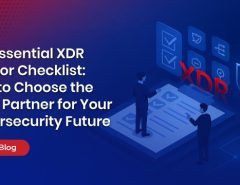What is XDR?
Let us understand what is XDR, also called as Extended Detection and Response. XDR is a cybersecurity solution that goes beyond traditional security measures by unifying threat data from various sources within an organization’s IT ecosystem. XDR provides enhanced visibility and context into advanced threats by collecting and correlating data from email, endpoints, servers, cloud workloads, and networks. This comprehensive approach allows security teams to analyse, prioritize, hunt, and remediate threats more effectively, reducing the severity and scope of potential attacks.
XDR leverages advanced analytics and automation to detect and respond to both known and emerging threats. By employing machine learning algorithms and behaviour anomaly detection, XDR can identify suspicious activities that may indicate a cybersecurity incident. This proactive approach enables organizations to mitigate risks and immediately prevent data loss and security breaches.
How does XDR work?
XDR employs automation for broad visibility, providing context to understand threats efficiently.
Data Collection and Integration: Monitors data across an enterprise’s tech environment, identifying incidents and threats from endpoints to the cloud. Optimizes security alerts by collating related occurrences.
Unified Analytics: Automates analysis of correlated incidents, enabling swift response and remediation. AI (Artificial Intelligence) and machine learning analyse data points in real-time, outpacing manual efforts in identifying attacks and malicious behaviour.
Incident Response: Allows automated or manual responses to threats. Utilizes preset conditions for actions like device quarantine and threat remediation. Security analysts review incident reports, recommend solutions, and take appropriate actions.
Use Cases of XDR
- Identify endpoint vulnerabilities for proactive defence.
- Hunt threats across diverse domains for comprehensive security.
- Investigate and respond swiftly to security events.
- Conduct health checks on endpoint devices for a robust defence.
- Predict and pre-emptively address potential future cyber-attacks.
- Prioritize and correlate alerts for efficient incident response.
- Responding and remediating incidents automatically and comprehensively, without user intervention
Benefits of XDR
XDR offers multiple benefits to enterprises, giving them holistic, flexible, and efficient protection against threats.
- Increased Visibility: XDR enhances security visibility by integrating data from various sources, providing a comprehensive view of the enterprise’s security landscape. This broadens threat awareness, establishes connections between alerts and incidents, and streamlines analyst efforts.
- Alert Management: XDR minimizes manual investigation time for analysts by correlating alerts, streamlining notifications, and reducing inbox noise. The system’s collation of related alerts enhances efficiency and offers a more comprehensive incident overview.
- Incident Prioritization: XDR assesses incidents, assigning weights to prioritize remediation. It recommends actions aligned with industry standards, regulatory requirements, or customized enterprise criteria.
- Automated Tasks: XDR features automation tools that reduce analyst workload by handling repetitive tasks.
- Increased Efficiency: Centralized management tools in XDR enhance alert accuracy and simplify the analyst’s task by consolidating threat assessment solutions.
- Real-time Threat Detection: XDR identifies threats in real-time and swiftly deploys automated remediations, minimizing an attacker’s access to enterprise data and systems.
- Integrated Response: XDR ensures a cohesive response across multiple security tools by remediating threats across all enterprise security products. It provides centralized analytics, response, and remediation capabilities.
EDR vs. XDR: What is the Difference?
While EDR and XDR are designed to enhance an organization’s security posture, they differ in focus, coverage, and capabilities. Here are some key differences between EDR and XDR:
- Scope: EDR focuses primarily on endpoint security, providing visibility and protection for individual devices within the network. In contrast, XDR takes a broader approach by integrating data from multiple security layers, including endpoints, networks, clouds, and applications.
- Coverage: EDR solutions are limited to monitoring and protecting endpoints, while XDR provides a more comprehensive view of the entire infrastructure, delivering cross-control-point protection and visibility.
- Data Analysis and Correlation: EDR primarily analyses endpoint data, while XDR collects and correlates data from multiple sources to provide a unified view of the organization’s security landscape.
- Automation and Orchestration: XDR typically offers more advanced automation and orchestration capabilities, enabling security teams to respond quickly and effectively to threats across multiple environments.
- Threat Hunting and Investigation: XDR solutions often provide enhanced threat hunting and investigation capabilities, allowing security teams to proactively search for potential threats and conduct in-depth investigations to understand the full scope of an incident.
EDR vs MDR vs XDR
Although XDR, EDR, and MDR use advanced analytics for threat detection, they differ in terms of scope. While EDR solutions only provide endpoint protection by monitoring endpoints, such as laptops, desktops, and servers, for signs of a security breach, MDR solutions offer a broader scope of protection by monitoring threats across multiple endpoints, networks, cloud environments, and other data sources. And XDR solutions extend beyond MDR’s scope as they integrate data across different security silos, delivering broader visibility and more precise incident response actions across different security domains.
SEQRITE XDR solution
SEQRITE XDR is a comprehensive incident response tool that integrates data from various security products, providing unified protection against cyberattacks. Through analytics and automation, it centralizes, normalizes, and correlates data in real time, enhancing security processes. SEQRITE XDR blocks cyber threats by detecting and shutting down malicious encryption processes before they can disrupt the network.
Frequently Asked Questions About XDR
What is XDR?
Gartner defines XDR as a “unified security incident detection and response platform that automatically collects and correlates data from multiple proprietary security components.
What is the Difference Between XDR vs. SIEM?
XDR is like an upgraded security system compared to SIEM. While SIEM looks at network logs, XDR checks a broader range of data like endpoints, network traffic, and the cloud. XDR gives a better picture of security and can spot and handle threats more effectively using advanced tools.
What is the difference between XDR and MDR (Managed Detection and Response)?
MDR outsources network security responsibilities to experts for threat detection and response, whereas XDR places the management responsibility on the implementing organization. MDR uses XDR systems.




